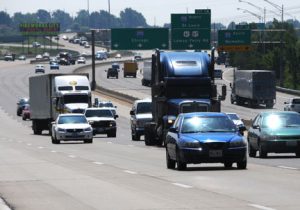East-West Gateway Council of Governments (EWG) is responsible for developing the St. Louis region’s Long Range Transportation Plan (LRTP) and Transportation Improvement Program (TIP). The LRTP presents the vision and priorities for the St. Louis region’s transportation system. The TIP sets out a four-year financial and implementation schedule for projects in the region receiving federal transportation funding. The Conformity Determination process is required by the Clean Air Act which established the framework for improving air quality to protect public health and the environment and is spelled out in federal regulations.
EWG’s Board of Directors approved Conformity Determination for the FY 2025-2028 TIP and related amendments to Connected 2050 at their August 28, 2024 Board meeting.
On September 30, 2024, the Federal Highway Administration and the Federal Transit Administration concurred with this conformity determination.
The Air Quality Conformity Process
 A major objective of the EWG transportation planning process is to ensure that the projects and policies set out in the TIP and related amendments to the LRTP help to reduce and minimize air quality impacts of transportation projects in accordance with federal, state, and local air quality standards, regulations, and priorities.
A major objective of the EWG transportation planning process is to ensure that the projects and policies set out in the TIP and related amendments to the LRTP help to reduce and minimize air quality impacts of transportation projects in accordance with federal, state, and local air quality standards, regulations, and priorities.
The specific procedures for reaching this objective are established under federal law for ensuring conformity between transportation plans and air quality improvement plans. The conformity process is intended to ensure that the programs and activities proposed in LRTPs and associated TIPs conform to the purpose of air quality State Implementation Plans, which set out benchmarks against which progress is measured in meeting national goals for cleaner and healthier air.
Under the federal regulations, EWG, as the St. Louis region’s metropolitan planning organization (MPO), is the agency responsible for conducting this determination of conformity. To accomplish conformity determination, a series of computer modeling exercises calculate vehicle emissions from the proposed St. Louis transportation system as compared to motor vehicle emissions levels set by Illinois and Missouri. The process is performed with input from the Air Quality Advisory Committee (AQAC) and the Inter-Agency Consultation Group (IACG).
Conformity Determination Elements
The conformity determination consists of two elements: the regional emission analysis and an assessment of progress in implementing Transportation Control Measures (TCMs). The transportation conformity finding relates to those precursor pollutants produced by automobiles and other on-road transportation, generally described as “mobile source emissions.” The pollutant of most concern in this region is ozone and its precursors, oxides of nitrogen (NOx) and volatile organic compounds (VOCs).
Conformity Determination Reference Materials
Additional information and resources about the Conformity Determination are available below.
EWG Documents
- Conformity Determination Users Guide
- CO or PM2.5 “Hot-Spot” Analysis Considerations for Project Sponsors (March 2013, Foreword January 2024)
- Regionally Significant Project Screening Criteria (February 2012, Introduction updated 2023)
- Federal Partners Baseline Assessment Review of the Regional Emissions Analysis and Transportation Conformity Determination Process at East-West Gateway (March 2012)
- Travel Demand Modeling and Motor Vehicles Emission Simulator (MOVES) Modeling (May 2012)
- St. Louis Inter-Agency Conformity Guide (April 2009)
Federal Resources
- The U.S. Environmental Protection Agency (EPA) hosts an extensive library of transportation conformity guidance.
- The EPA also hosts future versions, the latest user guides and technical information for the MOVES modeling system.
- The Federal Highway Administration’s (FHWA) transportation conformity site has additional conformity information.

